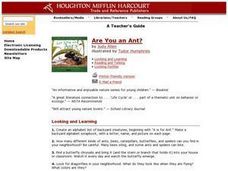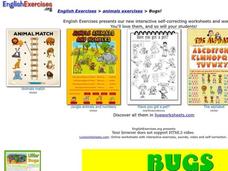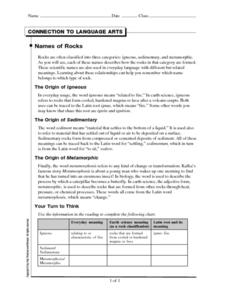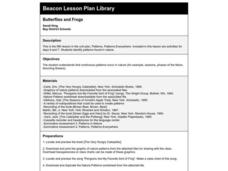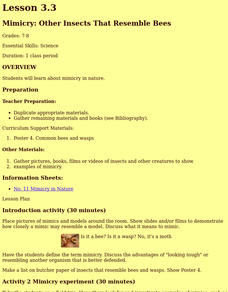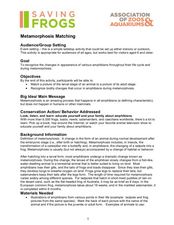Curated OER
Are You an Ant?
Students investigate different insects in their backyard. In this insect lesson plan, students read the book Are You and Ant? and apply the reading to their backyards. Students create a list of animals that begin with the the letter A an...
Curated OER
Beautiful Bugs
Learners investigate the life cycle of ants, ladybugs, and butterflies. They list the four stages of the butterfly life cycle, define symmetry and observe how ants make homes in dirt.
Curated OER
Interesting Insects
In this insects worksheet, learners read about insects and then answer the 10 questions pertaining to what they just learned. The answers are on the last page.
Curated OER
Bugs!
For this bugs worksheet, students watch a video about bugs, unscramble letters to make bug words, answer yes or no questions pertaining to bugs, and more. Students complete 6 activities total.
Curated OER
Spring Word and Picture Matching
In this matching worksheet, students match words and pictures related to Spring: flowers, rainbow, butterfly, ladybug, groundhog, caterpillar.
Curated OER
Names of Rocks
In this types of rocks instructional activity, students read about igneous rocks, sedimentary rocks and metamorphic rocks. They complete a chart about the three types of rocks and use the information from the reading to determine the...
Curated OER
Metamorphosis
Students select organic object and transform it to an inorganic object in five or six steps, and complete value rendered drawings.
PreKinders
Colors of Nature
The colors of nature are the most beautiful and vivid colors in the world. Show kids the ways that colors are striking and changing throughout different habitats with a set of images that feature two animals or plants for each color.
Curated OER
Life Cycles: A Never-Ending Story
Second graders describe the sequence of events in the life cycles of a butterfly, frog, and a deer. They observe the differences and similarities of parents and babies. They also discover that at different stages the animals can be...
Curated OER
Insects
Students study the characteristics and basic needs of insects. They compare and describe similarities among insects. They examine the body structure, covering, and movement of insects and also, examine insect life cycles in this unit of...
Curated OER
Cycles of Life
Students begin their study of insect life cycles by listening to a read aloud of Eric Carle's The Very Hungry Caterpillar. They learn the vocabulary of metamorphosis including egg, larva, pupa, chrysalis, and adult. They observe actual...
Curated OER
How Hot is Too Hot?
Fifth graders use the scientific method to conduct experiments on the temperature effects on organisms. In this temperature effects on organisms lesson plan, 5th graders observe and record the hatching or the developing of organisms into...
Curated OER
Understanding Cause and Effect using A Sound of Thunder
Students listen to a short story, A Sound of Thunder, and retell parts of the story which is about time travel. They respond to the story by writing cause/effect outcomes about the ecosystem using a handout.
Curated OER
Sentence Bulls Eye
In this recognizing subject-verb agreement instructional activity, students observe the Bulls Eye graphic organizer and draw two lines from each beginning through two middles and two endings to form complete sentences. Students construct...
Curated OER
Spring Word Search
In this spring activity instructional activity, students use the 50 words in the word bank to locate and identify them in the word search puzzle.
Curated OER
Searching for Spring ...
In this spring activity worksheet, students use the 30 words in the word bank to locate and identify them in the word search puzzle.
Curated OER
Spring Challenge
In this spring activity worksheet, students use the 79 words in the word bank to locate and identify them in the word search puzzle.
Curated OER
"What Insecit Am I"
Young scholars play the game "What Insect Am I" to explore the parts of an insect and their habitats.
Curated OER
Mimicry: Other Insects That Resemble Bees
Students design a conceptual experiment to test whether mimics actually benefit from the fact they resemble other organisms or objects. They define the term mimicry. They focus on insects that resemble bees and wasps.
Curated OER
Development in Drosophila melanogaster
Students study the least familiar aspect of development in Drosophila melanogaster; the development of the pupa. Students isolate and culture "First-day" pupae. They are dissected daily to study the progressive developmental changes.
Curated OER
Simple Cycles
Students use Inspiration to map cyclical events. They recognize links between separate events and structural patterns. They explore the Internet Connection section to browse additional resources on teaching about cycles used in...
Curated OER
Metamorphosis Matching
Young scholars view pictures of animals as they complete the metamorphosis from a larva to an adult. In this metamorphosis lesson plan, students view pictures and in the end are able to match pictures of a larva stage to an adult stage...
Curated OER
Life Cycles
Students explore the life cycle of living things through the eight lessons of this unit. The butterfly, frog, chicken, and plant are inspected and form the basis of the work done in this unit.


